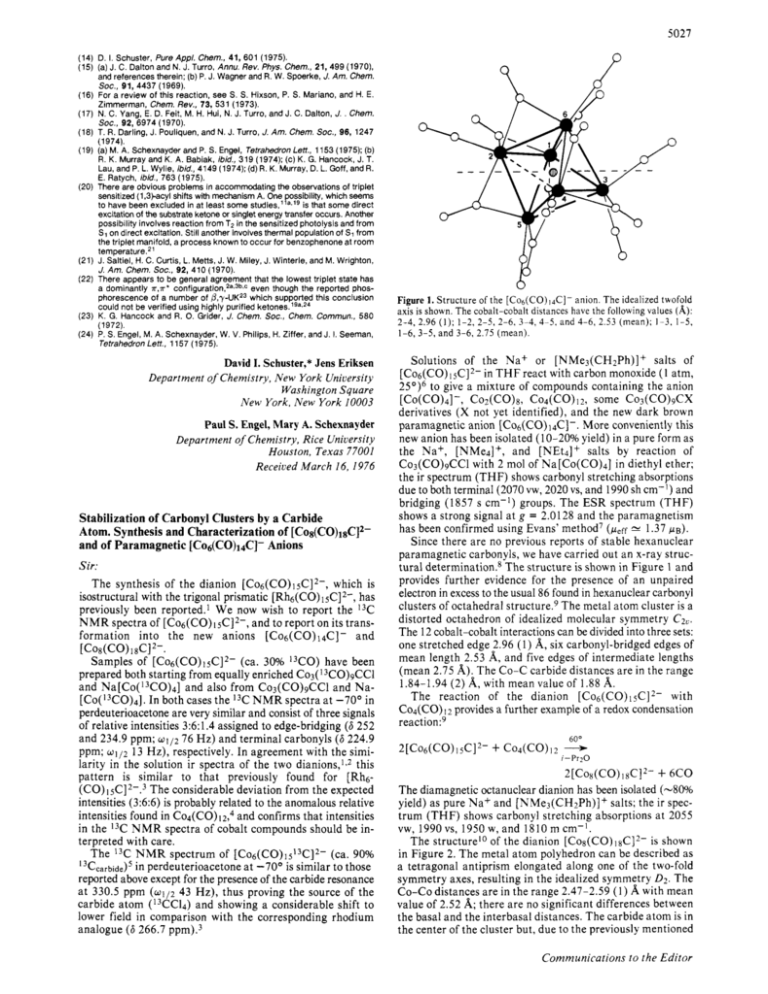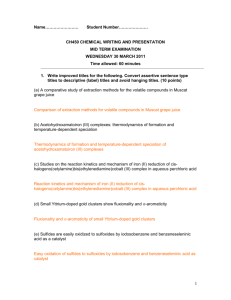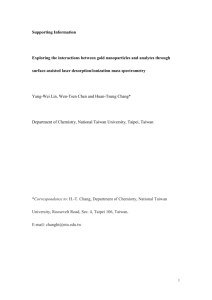5027 David I. Schuster,* Jens Eriksen Department of Chemistry
advertisement

5027 D. I. Schuster, Pure Appl. Chem., 41, 601 (1975). (a) J. C. Dalton and N. J. Turro. Annu. Rev. Phys. Chem., 21, 499 (1970), and references therein: (b) P. J. Wagner and R. W. Spoerke, J. Am. Chem. SOC.,91, 4437 (1969). For a review of this reaction, see S.S.Hixson, P. S. Mariano, and H. E. Zimmerman, Cbem. Rev., 73, 531 (1973). N. C. Yang, E. D. Feit, M. H. Hui, N. J. Turro, and J. C. Dalton, J. . Chem. SOC., 92, 6974 (1970). T. R . Darling, J. Pouliquen, and N. J. Turro, J. Am. Chem. SOC., 96, 1247 (1974). (a) M. A. Schexnayder and P. S.Engel, Tetrahedron Lett., 1153 (1975); (b) R. K. Murray and K. A. Babiak. ibid., 319 (1974); (c) K. G. Hancock, J. T. Lau, and P. L. Wylie. ibid., 4149 (1974); (d) R. K. Murray, D. L. Goff, and R. E. Ratych, bid., 763 (1975). There are obvious problems in accommodating the observations of triplet sensitized (l,3)-acylshifts with mechanism A. One ossibility, which seems to have been excluded in at least some s t ~ d i e s , ' ~is . ' that ~ some direct excitation of the substrate ketone or singlet energy transfer occurs. Another possibility involves reaction from T2 in the sensitized photolysis and from S1 on direct excitation. Still another involves thermal population of SIfrom the triplet manifold, a process known to occur for benzophenone at room temperature.21 J. Saltiel, H.C. Curtis, L. Metts, J. W. Miley, J. Winterle, and M. Wrighton, J. Am. Cbem. SOC.,92, 410 (1970). There appears to be general agreement that the lowest triplet state has a dominantly r,r* onf figuration,^^.^^.^ even though the reported phosphorescence of a number of p,y-UKZ3which supported this conclusion could not be verified using highly purified ketone^.'^^^*^ K. G. Hancock and R. 0. Grider, J. Cbem. SOC., Cbem. Commun., 580 (1972). P. S.Engel, M. A. Schexnayder, W. V. Philips, H.Ziffer, and J. I. Seeman, Tetrahedron Lett.. 1157 (1975). Figure 1. Structure of the [Cog(C0),4C]- anion. The idealized twofold axis i s shown. The cobalt-cobalt distances have the following values (A): 2-4, 2.96 (1); 1-2, 2-5, 2-6. 3-4, 4-5, and 4-6, 2.53 (mean); 1-3, 1-5, 1-6,3-5, and 3-6, 2.75 (mean). Solutions of the N a + or [NMe3(CH>Ph)]+ salts of [Co6(CO)i5CI2- in THF react with carbon monoxide ( 1 atm, 25°)6 to give a mixture of compounds containing the anion [Co(CO)4]-, Co2(CO)8, Co4(CO)l2, some C O ~ ( C O ) ~ C X derivatives (X not yet identified), and the new dark brown Paul S. Engel, Mary A. Schexnayder paramagnetic anion [ C O ~ ( C O ) ~ ~ CMore ] - . conveniently this new anion has been isolated (10-20% yield) in a pure form as Department of Chemistry, Rice University the Na+, [NMe4]+, and [NEt4]+ salts by reaction of Houston, Texas 77001 Co3(CO)9CCl with 2 mol of Na[Co(C0)4] in diethyl ether; Received March 16, 1976 the ir spectrum (THF) shows carbonyl stretching absorptions due to both terminal (2070 vw, 2020 vs, and 1990 sh cm-I) and bridging (1857 s cm-I) groups. The ESR spectrum (THF) shows a strong signal a t g = 2.0128 and the paramagnetism Stabilization of Carbonyl Clusters by a Carbide has been confirmed using Evans' method' (peff = 1.37 p g ) . Atom. Synthesis and Characterization of [Cos(C0)1&l2Since there are no previous reports of stable hexanuclear and of Paramagnetic [Co6(CO)14C]- Anions paramagnetic carbonyls, we have carried out an x-ray strucSir: tural determination.8 The structure is shown in Figure I and provides further evidence for the presence of an unpaired The synthesis of the dianion [co6(co)15c]2-, which is electron in excess to the usual 86 found in hexanuclear carbonyl isostructural with the trigonal prismatic [Rh6(CO) l5Cl2-, has clusters of octahedral s t r u ~ t u r eThe . ~ metal atom cluster is a previously been reported.' W e now wish to report the I3C distorted octahedron of idealized molecular symmetry C2L.. N M R spectra of [ c o 6 ( c o ) ~ ~ c ] 2and - , to report on its transThe 12 cobalt-cobalt interactions can be divided into three sets: formation into the new anions [ c o 6 ( c o ) 1 4 c ] - and one stretched edge 2.96 (1) A, six carbonyl-bridged edges of [ ~ ~ 8 ( ~ ~ ) 1 8 C ~ 2 - ~ mean length 2.53 A, and five edges of intermediate lengths Samples of [c06(co)15c]2- (ca. 30% I3CO) have been prepared both starting from equally enriched C O ~ ( ' ~ C O ) ~ C C I(mean 2.75 A). The Co-C carbide distances are in the range 1.84-1.94 (2) A, with mean value of 1.88 A. and Na[Co(l3CO)4] and also from Co3(CO)9CC1 and N a The reaction of the dianion [Cog(C0)15Cl2- with [ C O ( ~ ~ C O In ) ~both ] . cases the 13CN M R spectra a t -70" in Co4(CO)12 provides a further example of a redox condensation perdeuterioacetone are very similar and consist of three signals rea~tion:~ of relative intensities 3:6:1.4 assigned to edge-bridging (6 252 60" and 234.9 ppm; 0 1 1 2 76 Hz) and terminal carbonyls (6 224.9 2[co6(Co)l5c]2- + C04(CO)i2 --+ ppm; 0 1 1 2 13 Hz), respectively. In agreement with the simii-Pr2O larity in the solution ir spectra of the two dianions,Is2 this 2[CO8(Co) ISC]*- 6CO pattern is similar to that previously found for [Rh6The diamagnetic octanuclear dianion has been isolated (-80% (CO) The considerable deviation from the expected intensities (3:6:6) is probably related to the anomalous relative yield) as pure N a + and [NMe3(CH2Ph)]+ salts; the ir specintensities found in Cod(C0) 12,4 and confirms that intensities trum ( T H F ) shows carbonyl stretching absorptions a t 2055 vw, 1990 vs, 1950 w, and 1810 m cm-I. in the I3C N M R spectra of cobalt compounds should be interpreted with care. The structurelo of the dianion [Co8(Co)lgc]2- is shown in Figure 2. The metal atom polyhedron can be described as The I3C NMR spectrum of [c06(co)15'3c]2- (ca. 90% a tetragonal antiprism elongated along one of the two-fold 13Ccart,ide)Sin perdeuterioacetone a t -70" is similar to those symmetry axes, resulting in the idealized symmetry D2. The reported above except for the presence of the carbide resonance a t 330.5 ppm ( ~ 1 1 243 Hz), thus proving the source of the Co-Co distances are in the range 2.47-2.59 (1) A with mean carbide atom (13CC14) and showing a considerable shift to value of 2.52 A; there are no significant differences between lower field in comparison with the corresponding rhodium the basal and the interbasal distances. The carbide atom is in analogue (6 266.7 ppm).3 the center of the cluster but, due to the previously mentioned David I. Schuster,* Jens Eriksen Department of Chemistry, New York University Washington Square New York, New York 10003 + Communications to the Editor 5028 (1 1) V. G. Albano. P. Chini, S. Martinengo, M. Sansoni, and D. Strumolo, to be submitted to J. Chem. SOC. Vincenzo G . Albano 1st it u to Chimico “Ciamician” dell’Universitd 401 26 Bologna, Italy P Paolo C h i , * Gianfranco Ciani Mirella Sansoni, Donatella Strumolo Istituto di Chimica Generale dell’Universitd 201 33 Milano. Italy 0- Brian T. Heaton Chemical Laboratory, University of Kent Canterbury, England ‘s Second0 Martinengo Centro del C N R sui bassi stati di ossidazione 201 33 Milano. Italy Received March 30, 1976 b Figure 2. Structure of the [Co~(C0)18C]*-dianion. The twofold axes apply only to the metal atoms cluster and are indicated by dotted lines: one bisects Cos-Co8 and C O I - C O ~the , other C O Z - C Oand ~ Co4-Co6. The third axis is normal to the paper. distortion, it is not equidistant from the cobalt atoms, the Co-C carbide distances being in the range 1.95-2.20 (2) A with a mean value of 2.07 A. The deformation of the antiprism and the long CO-C,,rI,ide distances probably represent a compromise situation in which bonding of the carbide atom is still possible in the large cavity of this polyhedron. The carbonyl groups can be divided into two sets of nine terminal and nine edge-bridging, although some of the bridging groups are markedly asymmetric. It is worth noting that the isoelectronic Rhg(C0)lsC has a different structure in which a trigonal prism of rhodium atoms has been capped both along a square face and along one of the triangular edges.] The series of anions [Co6(CO)lgC]*-, [CO~(CO)I&]-,and [Cog(C0)1gC]~-provides a further example of the unusual stability of carbide carbonyl clusters,’ which we attribute to the presence of additional bonds with the central carbon atom. Further details of this and other studies of cobalt and rhodium] carbonyl carbide clusters will be reported later. ’ Acknowledgments. We thank the C N R for financial support and Nato for a grant. References and Notes (1) V. G. Albano, P. Chini, S.Martinengo, M. Sansoni, and D. Strumolo, J. Chem. SOC.,Chem. Commun., 300 (1974). (2) V. G. Aibano, M. Sansoni, P. Chini, and S.Martinengo, J. Chem. Sm.. &hon Trans., 651 (1973). (3) V. G. Albano, P. Chini. S. Martinengo, D. J. McCaffrey. D. Strumolo. and B. T. Heaton, J. Am. Chem. SOC.,96, 8106 (1974). (4) M. A. Cohen, D. R. Kidd. and T. L. Brown, J. Am. Chem. SOC.. 97, 4408 ( 1975). (5) [ C O & O ) , ~ ’ ~ C ] ~(ca. 3 0 % ’%O) was prepared from C O ~ ( C O ) ~ ’ ~ C C I ( N ~ [ C O ( C O )and ~ ] l3CCI4)and Na[Co(’%0)4]. ( 6 ) The reaction has a considerable induction period (1-2 h), which can be eliminated by addition of preformed Co3(CO)&CI. (7) In acetone containing 3 % benzene. D. F. Evans, J. Chem. SOC.,2003 (1959). (8) The salt [NMe4] [ C O ~ ( C O ) , ~ crystallizes C] in the P i space group with cell constantsa= 12.17(1)A, b = 13.28(1)A, c = 8.67(1)A,a=97.78(9)0. /3 = 89.93 (9)’, y = 98.23 (9)’, and Z = 2. The structure has been solved using 1474 diffraction intensities collected by counter methods. The refinement is in progress, the current R value being 7.6%. (9) P. Chini, G. Longoni. and V. G. Albano, Adv. Organomet. Chem., 14, 285 (1976). (10) The salt [NMe3CH2Ph]z[Co&O)1 C ] crystallizes in the P i space group with cell constants a = 19.02 (2) b = 10.37 (1) A, c = 12.81 (1) A. a = 116.43 (9)’, ? = 88.90 (9)’, y = 95.53 (9)’, and Z = 2. The structure has been solved using 3560 diffraction intensities collected by counter methods. The refinement is in progress, the present conventional value of R being 8.9 % . 1, Journal of the American Chemical Society 1 98:16 Chromium(I1) Porphyrins and an Irreversible Dioxygen Complex Sir: We have recently been interested in the discovery of clean, high yield synthetic routes to low valent metalloporphyrins and more particularly in the generation of coordinatively unsaturated metalloporphyrins which are precursors to dioxygen complexes. The reaction of Cr(acac)2’ with MIIICl(porphyrin) complexes, presumably occurring via a bridged chlorine transfer redox mechanism,2 has proved to be a key step en route to dioxygen complexes derived from Fe(II)3 and MII(II)~ species. W e now report that this and another method can be exploited to reduce Cr(II1) porphyrins and present evidence that distinguishes the Cr(I1) d4 formulation of the reduced products from the possible alternative, namely, a Cr(II1) radical anion derived from porphyrin ring reduction. W e also report the first example of a dioxygen complex derived from Cr( 11). Under scrupulously oxygen-free conditions, green CrCl(TPP)5 is reduced by Cr(acac)2 in toluene or THF to give red-brown solutions from which purple crystals of Cr(TPP) can be isolated.’ Magnetic susceptibility measurements (Faraday method at 25 OC under an argon atmosphere) on these crystals and on the related C r ( 0 E P ) are consistent with a high-spin d4 configuration (peffcorr = 4.8 p ~ ) The . MI1’/” reduction potential for Cr is expected to be considerably more negatives than those of Co, Fe, and Mn raising the possibility of porphyrin ring reduction in preference to metal reduction. One criterion for distinguishing between metal and ligand redox reactions in metalloporphyrins, which apparently has wide general it^,^ is that the numerical difference between the half-wave potential of the first ligand oxidation in nitrile solvents and the first ligand reduction in MeZSO, A E I / ~ ~is ~ / ~ ~ ~ , 2.25 f 0.15 V. As with Cr(OH)(OEP),lO cyclic voltammetry a t Pt on CrCl(TPP) in benzonitrile and in Me2SO (Figure 1) reveals six half-wave potentials relative to SCE. W e have assigned these potentials as follows: 1.15 and - 1.23 V to the first ligand oxidation and reduction, respectively; -0.86 V to CrI1I/l1;+0.95 V tentatively to CrI1l/lv; 1.41 V to the second ligand oxidation; and - 1.70 V to the second ligand reduction. W e note that AE1/20x/red is 2.38 V, and moreover, the differences between the first and second ligand reductions (0.47 V) and the first and second ligand oxidations (0.26 V) both lie in the normal ranges, 0.49 f 0.08 and 0.29 f 0.05 V, respectively.ll~12Exhaustive coulometry a t -1 .O V consumed one 1 August 4, 1976 + +





